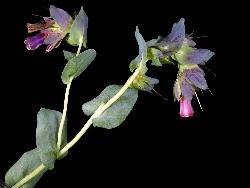- Taxon
- Gallery
- = Cerinthe aspera Roth
- = Cerinthe gymnandra Gasp. (1842)
Annual, with erect glabrous stems to c. 60 cm high, but often much less. Lvs on flowering stems sessile, cordate and amplexicaul, 2–6 × 1–2 cm; lower lvs oblong to broadly ovate below infl., glaucous, white- tuberculate and rough above. Cymes elongating to c. 12 cm long; bracts to c. 3 × 2.5 cm, broadly ovate to suborbicular, blue or bluish purple, tuberculate above, ciliate. Calyx slightly < bracts; lobes unequal, blue, ciliate. Corolla 1.8–2 cm long, pendent, the basal 1/2 yellow, narrowed, the upper 1/2 dark purple; lobes c. 1 mm long, recurved. Stamens reaching corolla mouth; filaments flattened; anthers 5–6 mm long. Style long-exserted, filiform. Nutlet pairs asymmetric, c. 4 mm diam., slightly beaked with broad flat base.
[From: Webb et al. (1988) Flora of New Zealand. Volume 4.]
Flowering: Mar.–Dec.




